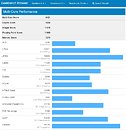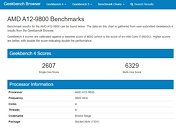Thursday, September 14th 2017

AMD Raven Ridge Ryzen 5 2500U with Vega Graphics APU Geekbench Scores Surface
A Geekbench page has just surfaced for AMD's upcoming Raven Ridge APUs, which bring both Vega graphics and Ryzen CPU cores to AMD's old "the future is Fusion" mantra. The APU in question is being tagged as AMD's Raven Ridge-based Ryzen 5 2500U, which leverages 4 Zen cores and 8 threads (via SMT) running at 2.0 GHz with AMD's Vega graphics.
According to Geekbench, the Ryzen APU scores 3,561 points in the single-core score, and 9,421 points in the multi-core score. Compared to AMD's A12-9800, which also leverages 4 cores (albeit being limited to 4 threads) running at almost double the frequency of this Ryzen 5 2500U (3.8 GHz vs the Ryzen's 2 GHz), that's 36% better single-core performance and 48% better multi-core performance. These results are really fantastic, and just show how much AMD has managed to improve their CPU (and in this case, APU) design over their Bulldozer-based iterations.
Source:
Guru3D
According to Geekbench, the Ryzen APU scores 3,561 points in the single-core score, and 9,421 points in the multi-core score. Compared to AMD's A12-9800, which also leverages 4 cores (albeit being limited to 4 threads) running at almost double the frequency of this Ryzen 5 2500U (3.8 GHz vs the Ryzen's 2 GHz), that's 36% better single-core performance and 48% better multi-core performance. These results are really fantastic, and just show how much AMD has managed to improve their CPU (and in this case, APU) design over their Bulldozer-based iterations.






54 Comments on AMD Raven Ridge Ryzen 5 2500U with Vega Graphics APU Geekbench Scores Surface
If so, that'd be pretty cool.
What Is known in that bulldozer APUs sucked HARD. Bristol ridge barely gets over 11GB/s bandwidth from 2400MHz memory, which is hypothetically capable of 34GB/s. this had to feed both the CPU and GPU. Their CPU cores were also unable to keep near full boost, meaning CPU performance was pathetic. The current bristol ridge APU is twice as fast as a 620 equipped intel CPU, yet it is also known that the GPU is running at less then half capacity. A 384 core 64 bit GCN chip is 40-60% faster then a 512 core desktop APU right now.
So assuming that AMD keeps the 512 core design, but uses ryzen CPU and memory controller, expect big boosts. Even a 256 core ryzen APU would be faster then AMDs current 512 core parts. Hypothetically, they have a 704 core GPU in the works for APUs.
My guess would be 512 core at 15 watt and 704 core for 35 watt and desktop parts.
Intel sucks at video rendering, upscaling, enhancements. Intel sucks at 3D graphics, great processors for the longest time, but their graphics suck as well.
www.anandtech.com/show/11538/the-microsoft-surface-pro-2017-review-evolution/5
Essentially any 7 year old midrange card or 5 year old entry level discreet card will kick it's ass.
Well, it destroyed my fixed 2GHz i3 on single thread performance.
This would be a more level comparison. With 35-45W to play with Intel can pack a much more potent iGPU.
Also there's managing expectations. Obviously a dedicated used GPU will be faster and probably cheaper, but still.
The best I could do I was 1366x768 on high details on most games 30fps with a 7850k @4.4Ghz core 975Mhz gfx with DDR3 2.4Ghz
I would be extatic if they could do 1080p medium details @30fps.
Support for dual-channel DDR3-1866 helped tremendously.
www.gsmarena.com/iphone_x_spotted_on_geekbench_iphone_7s_appears_on_antutu-news-27224.php
It's a MSI 350 gaming pro.
At least I hope they use AM4 for those APU's...
I kinda want my Ryzen 5 1400/ Vega APU...
My phone can play the games at 1080 (GTA3 for example) with HDMI interface to my TV or DLNA and offers the same performance in these light weight games, as do most tablets, again rendering the Intel graphics virtually pointless from a 3D standpoint.
The 640 vs the 930M the normalized power consumption shows very minor difference, and the only real difference was the size of batteries installed in the two devices.